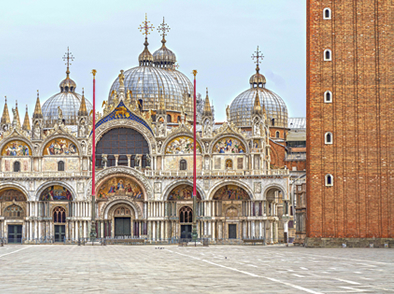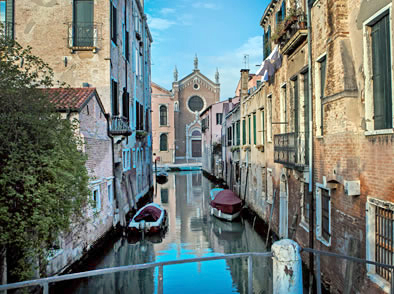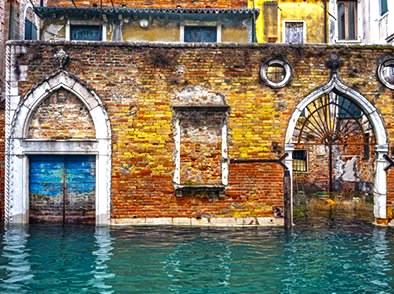Venetian Carnival
Venetian Carnival 1162-1797
Origin
Fat Thursday, also known as Berlingaccio, was the official carnival feast day of the Most Serene Republic. On that day the duke, with top government officials and foreign ambassadors, attended the scheduled shows from the loggia of the Ducal Palace overlooking the piazzetta.
Most notably we recall the fireworks, the ‘human pyramids’, and the so called ‘Fly of the Turk’, an acrobat tied up on a rope being slowly raised to the top of the bell tower and then playing an angel as he moved the fake wings of his costume. Once he reached the top, after he started his slow ‘flying’ descent, when he landed before the duke offering him a bouquet of flowers.
The origins of this show go back to 1162, the year Venetian authorities accepted Carnival as an official event. In the early days, the feast was to remember the Venetian victory of that year over the patriarch of Aquileia, a feudal landlord whose attempt to invade the city with his allies turned into his own defeat instead. The prelate had his life spared but he was obliged to provide the duke of Venice every year with one bull (to represent the patriarch) and twelve pigs (his deacons). The animals paraded in a crowded san Marco square until they got to the smaller piazzetta where they were put on ‘trial,’ found guilty, and beheaded by some nobles who shared the meat later. Finally the duke returned to his palace where he destroyed the scale models of fortresses representing those of the patriarch’s allies.
This grotesque performance of the historical events was to entertain the people of Venice, but also to strengthen the political hegemony of the ruling class.
It was in the 16th century that the feast celebrations got their final version as the bloody show was limited to just the bull beheading. The official shows and events remained the same until the fall of Venice in 1797. A new and more dignified image of the State was required at a time when Venice was about to start a restructuring of san Marco square in the new ‘Roman’ manner. Fat Thursday then stopped being the time where the nobles showed themselves before the people and became a show offered by them to the Venetian populace instead.
18th century
Carnival at this time was already a business run by professionals. A general manager or impresario will be appointed to oversee all the public events after a competition where several candidates presented detailed budgets and layouts for the shows.
During the last week of carnival, to end on Fat Tuesday just before Ash Wednesday, the piazza was crowded all day long with people gathering to attend all sorts of shows with acrobats, tumblers, charlatans, fortune tellers, animals such as dogs, monkeys, horses and bears, and puppets, while no one missed getting into a ‘new world’, a covered area where they could enjoy the optical marvels of dioramas and handmade slide projections.
In any of the streets around the square one could have seen people wearing all kinds of masks. Most popular were the ‘transvestites’ – adult men dressed and acting as women or young effeminate boys, and last but not least fake beggars showing deformities, ugliness and simulated sickness. Often all these masked people crossed the city parading and drawing the bystanders’ attention and becoming an attraction of their own. Masks and costumes could be many, among the most common the miser, the prostitute, the lawyer, the doctor plus all the characters of the popular theater (commedia dell’arte) like Arlecchino, Pulcinella, Pantalone, Brighella. Nobles and foreign guests used the more austere bauta combining a white mask, a tricorner hat, and a black wool mantel.
Oldest records about the use of masks date back to the 14th and 15th centuries, although the use of costumes spread in the 16th century. Obviously masked people in the city could bring concerns about public security, so all weapons and arms were prohibited even if part of a costume.
Another popular event took place in the campi (broad areas) of the city where a sort of fake corrida bull fight with sometimes pitbull dogs unleashed against the bigger animals.
Nobles sought for private and more reserved parties called festini held in the palaces organized as the public events by professional entrepreneurs, while the main concern of the government was to restrain gambling games and make sure the these parties were not just a cover for that. Nobles in Venice had their personal hideaways, smaller apartments called casini (casino singular) where they could lead their ‘private’ vices outside their official abode like banqueting, sex, and gambling, or just meeting friends and foreigners in an informal setting. Lots of casinos were kept open during carnival when the main activity then was gambling, not legal since it should be practiced officially only in the state owned gambling house the Ridotto, where all games were permitted. Playing cards without stakes was allowed although gambling was so spread and popular then that it could be easily identified with carnival itself. Venice’s casino will be the main attraction for a lot of foreigners during the century.
The other typical carnival activity was going to theater to attend opera or comedies. The first day of the new opera season, (first Sunday in October) also marked the beginning of the wearing of masks. Theater was extremely popular and in Venice, in the 18th cent. there were 7 places dedicated to performances, including proper theater and opera. The wide variety of shows and their quality will make Venetian theaters a magnet for foreign visitors. Music shows began in October while stage plays started soon after Christmas, and the season will continue until May. So the use of masks in Venice was allowed from October to the beginning of Lent to be resumed again for a couple of weeks during the feast of Assumption in May, about five months in a year.
Although the proper Carnival time began on December 26th, to be finished on Mardi Gras and climaxing on the very last week. With these features Venetian carnival became the most famous in Europe in the 18th century, but was also a clear sign of her vanishing reputation as a long standing European state. It’s true then that by the end of the century the authorities become less tolerant to the permissiviness that characterized carnival, interpreting from the changing feelings of public opinion that saw the excesses of carnival as a condition of the city’s decadence. The turning point in this new attitude was the closure of the Ridotto (official gambling house) in 1774 amidst the protest of mask makers and gondoliers……
Still, the Venetian carnival will attract visitors in big numbers, bringing a great amount of revenue to the city. There are no clear figures about the number of people arriving in Venice in the 18th century for carnival , although they can be accounted by the thousands. It’s true that more visitors came to Venice in May to attend the Assumption festival, since figures recall some forty thousand in mid in 1770’s, probably because of better weather and the ‘short’ carnival.
The city was a marvel in every way: the natural setting, the incredible number of art works and collections in palaces, churches, convents, the unmatched variety of public events and mostly sophisticated rituals set in san Marco square, the theatre and opera scene. And of course high rank prostitution for which Venice was long famous. Venice in the 18th century was a well prepared tourist destination. The number of stores steadily increased and they stayed open till late and in holidays, while the cafes open to public reached a record of 206. Also there was a wide variety in lodging offered including palaces, hotels, inns, rooms in private homes and pubs.
Present day carnival
Traditional carnival died out with the fall of Venice taken by the French troops in May 1797; only private parties in the palaces will be held up to mid 19th century when Venice will be united with the Italian Kingdom. Since then there aren’t any records of carnival activity until 1979 when the ‘new’ carnival will be brought back to life, but in a much smaller scale than the past.
The beginning is now on a Saturday with the most beautiful parade, the Festa delle Marie or the carnival queens. You should be around 2pm by the church of san Pietro di Castello to see how the participants in the parade get dressed with their medieval costumes while all prepared to start the parade to accompany the Queens all the way into a super-crowded san Marco square.
Next day, Sunday, is the official beginning of Carnival: the square is full of people in costumes while all wait until noon when a young lady in her angel costume start her ‘flying’ descent tied up on a rope from the top of the bell tower. Modern carnival lasts 11 days, the peaks being Fat Tuesday/ Mardi Gras.
Get in touch!
Which Venice will you discover?
INTRODUCTORY TOURS
These tours are intended for first time visitors who wish to become acquainted with Venice’s main sights and landmarks, gaining an overall picture of its history and modern-day life.
IN DEPTH TOURS
Art, in all forms has been a unique ingredient of Venice’s success. Discover the magnificence of the grand Venetian architects and painters. For the ones that live in the now the contemporary art, contemporary architecture and the truly authentic glass studios where masters are at work.
UNUSUAL TOURS
These tours are intended for visitors who wish to experience areas and sites rarely seen by tourists, in both urban locations and beyond. Take this opportunity to discover truly authentic art studios, furnaces and lagoon islands with us.




